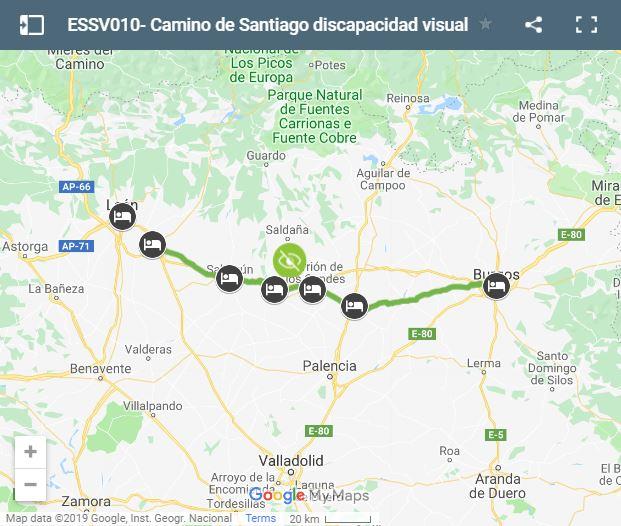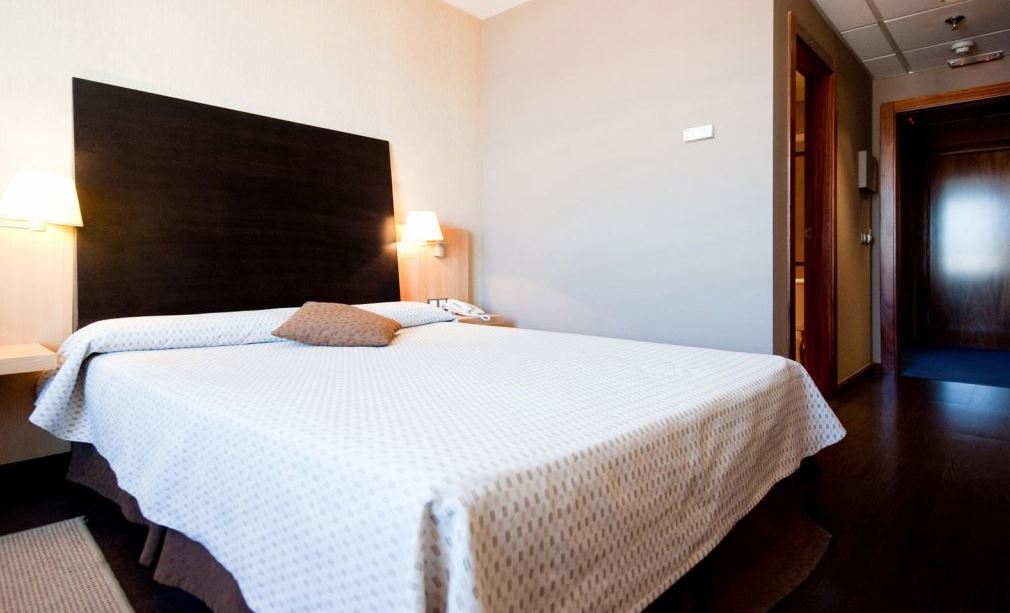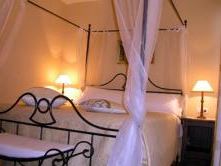- Carefully selected accommodations in rooms with private bathrooms to ensure maximum comfort
- Feasible stages without prolonged slopes, allowing enjoyment of each journey
- Fabulous gastronomy
- Heritage jewels of Romanesque and Mudejar art

Start: Burgos Finish: León
In general terms, the stages are flat. The type of surface is diferent on each stage, but most sections follow compact dirt tracks.
The stages selected for this trip have been chosen following careful consideration of the terrain, relief, possible dangers due to physical barriers, type of surface and availability of nearby accommodation with accessible facilities. However, there are some inevitable critical spots where those with visual or cognitive disabilities will need the help of their companion.
After checking in your hotel, you can spend the afternoon visiting Burgos, with a pedestrian old quarter and a very nice promenade along the Arlanzón River. This city welcomes visitors with some very nice restaurants to get in touch with the tasty gastronomy of Castilla y León. Tonight’s dinner is not included in the package, but you can arrange it yourself directly with the hotel or choose one of the restaurants we suggest in the historical old town.
After breakfast, an adapted taxi will take you to the beginning of the route in Castrojeriz, by Santa María del Manzano collegiate church. From there you ascend to reach the pass of Mostelares, the last moorland before reaching `Tierra de Campos´ in the province of Palencia. From here the landscape turns into endless plains and hills covered with crop fields. After passing San Nicolás hermitage (a former hospital) and crossing Fitero Bridge (Medieval bridge over Pisuerga River), you reach Itero de la Vega. After 8 km you arrive in Boadilla del Camino.
The second section until Frómista (6km / 3,5 mi) goes along the Canal de Castile on a compact dirt path. This Canal is a hydraulic structure built between the 18th-19th century and used to take cereal to the northern harbours and markets, currently used as an irrigation channel. In the afternoon, you will have time to visit some of the Romanesque architectonic jewels that Fromista hides.
Again, dinner is not included tonight, but there is a traditional rotisserie (Asador) next to the accommodation worth trying.
Villages on the way: Castrojeriz- Itero de la Vega - Boadilla del Camino - Frómista
Today’s stage goes along an easy path parallel to the main road P-980, with almost no slopes. Once in Población de Campos you follow a version of the official Camino through Villovieco. Later, the Camino goes along Ucieza River, a cool and shady section in case of higher temperatures. By the chapel of Nuestra Señora del Río, you will head Villalcázar de Sirga, with the monumental church of Santa María la Blanca.
Endless crop fields will accompany you along the way until Carrión de los Condes. This village has around 2000 inhabitants and offers all kinds of services and interest sites such as Sta. María de la Victoria’s Church, Santiago’s Church and the Monastery of San Zoilo.
Villages on the way: Frómista-Población de Campos-Villovieco-Villalcázar de Sirga-Carrión de los Condes
An adapted taxi will take you this morning to the beginning of the route, at a crossing with the Roman way Vía Aquitana. This stage is quite easy, flat and straight until Calzadilla de la Cueza, along a compact dirt/gravel track. On the way, you go past Calzadilla de la Cueza, a hiden village that seems like a western film set, with its cemetery tower and its surroundings. Its clay houses were built along an ancient Roman way which is now part of the Camino de Santiago. In Calzadilla you will also spot some dovecotes, typical from this area. Tonight’s accommodation is located at the end of the village.
Villages on the way: Carrión de los Condes-Calzadilla de la Cueza
Today’s stage begins in Cazadilla de la Cueza and you leave behind the lanscape from `Tierra de Campos ´and you enter the so-called Páramo Leónes. Adobe buildings and dovecotes form a territory once occupied by Templar Knights. You go past several villages with plenty of services.
On the first section of the day, you will walk along a branch of the French Way through growing fields, oak woods and crimson-spot rockroses. Further on, you will take an alternative route to avoid the tarmac road and reach Terradillo de los Templarios. The landscape will now be again covered with crop fields.
The stage ends in Sahagún, with a population of around 3000 inhabitants and all kinds of services. Don’t miss the San Lorenzo and San Tirso churches, of Romanesque – Mudejar style.
Villages on the way: Calzadilla de la Cueza-Lédigos- Terradillos de los Templarios- Moratinos-San Nicolás del Real Camino- Sahagún
From Sahagún to Burgo Ranero you follow the so-called `Real Camino Francés´; a part of the French Way that was commissioned by the monarch Carlos III in the 18th century, a wider track than the usual, made to fit noble and royal carriages. Today’s 18 km / 11 mi will be surrounded by crop fields walking along dirt/ gravel/ tarmac tracks. This section is in good condition and it will have its steepest strecht (80m ascent) after passing Bercianos del Real Camino.
Villages on the way: Sahagún-Bercianos del Real Camino-El Burgo de Ranero
Entering Reliegos there are some caves which were once used as wineries and now are used as meeting points. The most difficult section today is the one entreing Mansilla de las Mulas by a bridge over the N-60, here you will take a detour on the right of the bridge and cross the road with caution.
La Puerta del Castillo is the pilgrim’s access to Mansilla de las Mulas, a Medieval walled village over the Esla River which had up to 7 churches, 2 convents and 3 hospitals in its years of splendour. Don’t forget to taste the local wine! (vino Prieto Picudo)
Villages on the way: Burgo de Ranero-Reliegos-Mansilla de las Mulas
After breakfast, a taxi will take you directly to your hotel in León. After checking in there will be plenty of time to visit the most important monuments of the city, such as the Santa María’s Cathedral (12th-13th centuries), of Gothic style and with a magnificent stained glass window or the Basílica of San Isidoro. Art lovers can also enjoy visiting the Contemporary Art Museum (MUSAC). But if there is something León is well-known for, it is for the old quarter or Barrio Húmedo, a lively atmosphere full of `tapas´ bars. Stroll around San Martín Square and some of its better known streets, like calle Ancha, calle de la Rúa, calle Badillo and Las Cercas.
Today, after breakfast, your arrangement ends and you say farewell to León.
The accommodation selected for this trip has been chosen according to location (daily stages to be covered), comfort and accessibility, both in rooms and common facilities. The standard accommodation on this trip will be in hotels*** and hostels (rooms with private bathroom). When a standard accommodation is not available, these categories may vary. Extra nights may be booked in Burgos and León.

AD
www.hotelbulevarburgos.com








This trip can be done between 1 April-15 June and 1 September and 30 October.
Due to the extreme weather conditions of this area (cold winters and hot summers) and that many accommodations along the Camino are closed most of the year, this trip cannot be booked in July and August. Also, we try to avoid the peak season with crowds of people and lower availability in the accommodations.

If you are coming from abroad, the Aeropuerto de Madrid-Adolfo Suárez (MAD) is the best option to reach cities like Burgos and León by public transport. Also, this airport has a wider offer of international flights into Spain.
If you are flying into Bilbao (BIO) or Valladolid (VLL) you will also have good connections by public transport with either Burgos or León.

How to arrive in Burgos / Return from León
by Train
The train company RENFE offers several services from Madrid, Bilbao or Valladolid to Burgos. For more information: www.renfe.es
Train journey (direct)
From Madrid airport (MAD)
- Madrid-Burgos (16:05)
- León-Madrid (16:59h/18:50h)
From Bilbao airport (BIO)
- Bilbao-Burgos (17:00h /9:20h)
- León-Bilbao (15:44h)
From Valladolid airport (VLL)
- Valladolid-Burgos (15:17h/ 17:23h)
- León-Valladolid(15:50h/16:59h/18:50h)
by bus
bus company ALSA (www.alsa.es) offers this service. Visit its website to check timetables and prices.
Services for people with reduced mobility
- AENA service
www.aena.es . 902 404 704 & (+34) 91 321 10 00.
- Servicio Atendo RENFE
Main Customer Service office at Atendo
Train station Madrid-Atocha
Phone: 91 774 40 40
Opening hours: 6:00 to 24:00h
App Renfe Atendo www.play.google.com/store/apps
- ALSA Assistance Service
www.alsa.es/experiencia-alsa/planifica-tu-viaje/asistencia-especial#

Throughout the programme travellers will have private transfers to the start of each stage (if needed) , in addition to luggage transfer from hotel to hotel.
Included
- 8 nights' accommodation with breakfasts
- 7 dinners
- Luggage transport according to program* (1 piece per person, max. 18 kg)
- Transfers on days 2, 4 and 8
- Digital detailed route notes and maps in English
- Access to the trip on GUIBO
- Pilgrim passport
- 24-hour telephone assistance
*During high season, it must be left everyday by 8:00 hrs although you leave later
Not Included
- Lunches
- Dinner on day 1
- Trip insurance
- Personal expenses such as tips, phone calles, entrance fees, etc.
- Transport to first and from last accommodation
Extras
- Additional nights in Burgos or León
- Arrival/departure transfers to the airport
- Shipment of printed documents to the first accommodation












Opening hours: Mon-Fri 9:00am – 6:00pm (CET)
Opening hours: Mon-Fri 9:00am – 6:00pm (CET)